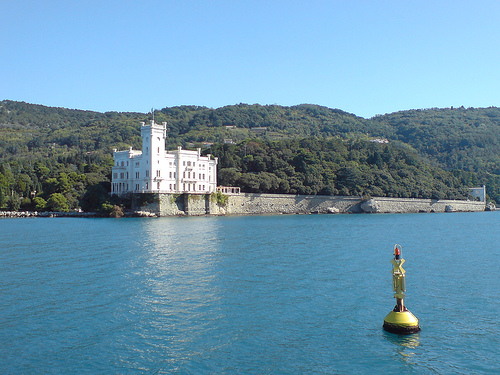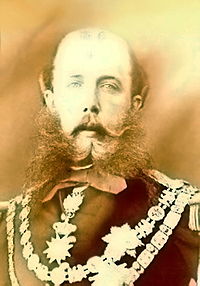

Location: Gulf of Trieste Map
Constructed: 1860 on orders of Maximilian I Emperor of Mexico
Open: 9am- 7pm daily
Tel. +39 040 22443
Entrance Fee: Euro 6, children free

Miramare Castle (Schloss Miramar in German; grad Miramar in
Slovenian) is a historic building and museum in Trieste. The
complex, surrounded by a large park, was originally built between
1856 and 1860 in the town of the same name as the residence of
Maximilian of Habsburg-Lorraine, archduke of Austria and later
emperor of Mexico, and his wife Charlotte of Belgium.
The
castle and park constitute one of the Italian state museums, which
in 2016 were granted special autonomy by the Ministry of Cultural
Heritage and Activities.
«O Miramare, to your white towers
wait for the rainy sky
gloomy with a flight of sinister birds
the clouds are coming."
(Giosuè Carducci, Odi barbare, Miramar)
Overlooking the Gulf of Trieste, it is located a few kilometers
north of the capital (about 6 km from the Central Station). Miramare
is the Italianized form of the original Miramar, deriving from the
Spanish "mirar el mar", as Maximilian of Habsburg, when visiting the
promontory that houses it, was inspired by the memory of Spanish
castles overlooking the coasts of the Atlantic Ocean.
The
castle is surrounded by a large park of about 22 hectares
characterized by a great variety of plants, many of which were
chosen by the archduke himself during his travels around the world,
which he made as admiral of the Austrian navy. In the park there is
also the castle, a smaller building which served as a residence for
the couple during the construction of the castle itself, but which
in fact became a prison for Carlotta when she lost her mind after
her husband was killed in Mexico.
Miramare castle "still has
the original period furnishings, evidence of the history of the
noble owners, the archduke and his wife Charlotte of Saxony,
daughter of the king of Belgium, and of their sad fate which did not
allow them to enjoy the splendid mansion". Inside, the castle is
divided into numerous rooms. The ground floor was intended as the
residence of Emperor Maximilian I and his wife Carlotta, while the
upper floor was later used as the residence of Duke Amedeo of Aosta,
who lived there for about seven years and modified some rooms
according to the style of the era. The Imperial-Royal insignia were
removed and replaced with Savoyard crosses.
A sad fate unites
those who lived in Miramare: Maximilian of Habsburg left to assume
the imperial crown of Mexico and died there, while Amedeo left for
the Ethiopian Empire of which he was viceroy and died in captivity.
The first idea of building a castle on the promontory near the bay
of Grignano came to Maximilian in 1855. The area had to be
reclaimed, but the large space available would have been the ideal
place for the emperor's brother to give free rein to his passion for
botany, creating a garden into which the archduke will then bring
together the numerous rare plants imported overseas.
Work
began on 1 March 1856, and the project was entrusted to the Viennese
architect Carl Junker. The first drawing did not convince
Massimiliano, who asked Giovanni Andrea Berlam for an alternative
one, remaining satisfied. However, it was Junker's second project
that became the definitive one.
The model refers to the
current - clearly neo-medieval in taste - called romantisches
Historismus, developed in those years by Theophil Hansen at the
Vienna Arsenal and at Villa Pereira, just north of the imperial
capital. However, the main ideal which inspired the architect and
client of Miramare is that made manifest by Karl Friedrich Schinkel
in the construction of Schloss Babelsberg in Potsdam and Schloss
Kurnik in Poland.
The castle was initially supposed to
consist of three floors and a mezzanine, but Massimiliano, who
despite residing in Milan often went to Trieste to follow the
progress of the works, decided in 1858 to eliminate one floor.
Meanwhile, Franz and Julius Hofmann, who had been entrusted with the
decoration of the interior, were already well advanced.
With
the forfeiture of the governorship of the Lombardy-Veneto Kingdom in
1859, Maximilian moved with Carlotta to Miramare, first staying in
the small castle and, starting from Christmas 1860, in the main
building. Massimiliano, a lover of sea life, wanted his own private
studio overlooking the Gulf of Trieste and decorated like the
interior of a ship. The following year, the owner of the house made
a trip to Brazil, taking the opportunity to catalog some species of
plants.
When he returned, he stayed permanently in Miramare,
where he also hosted his brother Emperor Franz Joseph I of Austria
and his wife Elisabeth of Bavaria, known as Sissi. From there on
April 14, 1864, at the invitation of Napoleon III, he set sail with
his wife for Mexico, aboard the frigate Novara, the same ship that
would bring back his body four years later. Carlotta regained
Trieste in 1866, but her husband was shot in Querétaro the following
June.
Carlotta began to show signs of insanity and she was
locked up in the castle. Shortly thereafter she returned to her
native Belgium.
The interior was meanwhile completed. The
couple's neo-Gothic and neo-medieval apartments were finished in
1860, while the completion of the reception area ten years later
determined the end of the works.
Between 1930 and 1937 the
castle was the residence of Duke Amedeo of Savoy-Aosta and his wife
Anna d'Orléans.
At the end of 1945, New Zealand troops under
the command of General Freyberg entered Trieste and installed
themselves in the castle, making many changes inside. British troops
subsequently placed XIII Corps headquarters at Miramare. Eventually
the Americans arrived and the castle served as headquarters for the
American garrison Trieste United States Troops (TruSt) from 1947 to
October 3, 1954. The Superintendence immediately began restoring the
interior of the castle, the castle and the structure of the park.
Based on drawings and photographs of the time, the wooden
decorations were put back into the rooms and the furniture,
furnishings, paintings and tapestries were rearranged.
The park of Miramare extends overlooking the gulf of Trieste on an
area of 22 hectares on the Karst promontory of Grignano, at the time
of the construction of the castle almost devoid of vegetation; it
was designed by the Austrian architect Carl Junker (1827-1882) at
the behest of Archduke Maximilian. The gardener Josef Laube was
initially commissioned for the botanical design, then replaced in
1859 by the Bohemian Anton Jelinek.
The park, whose work was
started in the spring of 1856, represents an example of a mixed
artificial planting of forest essences, trees and bushes that blends
the charm of a Mitel-European architectural environment and a
Mediterranean landscape. In contrast to the Baroque garden, the
English one, on which Miramare is modeled, introduces a new
relationship with nature, the result of a different sensitivity
towards the material world.
Before 1856 the park area was
bare, with only a few thorny shrubs and bushes. Today, however,
there is a group of different tree species which are, for the most
part, of non-European origin or otherwise which are not native to
the area. Within a ten-year period, cedars from Lebanon, North
Africa and the Himalayas were planted firs and spruces from Spain,
cypresses from California and Mexico, various pine species from Asia
and America, and some exotic specimens , such as giant sequoia and
ginkgo biloba have been added. Miramare was conceived as a private
garden and not as a park. In reality it does not have a monumental
entrance or a driveway leading up to the castle. It was a garden of
wonders, not intended for public use, although the archduke opened
it to the common people a couple of days a week. Watercourses,
pools, winding paths, trees arranged in natural patterns, some
grassy areas, are typical of English gardens. The roughness of the
terrain has favored the irregular disposition of the promontory
which unites the artificial transformation with the natural
environment.
The park is also characterized by the presence
of some buildings included in Junker's project: the small castle,
inhabited by Massimiliano and Carlotta, whose construction began at
the same time as the construction works on the castle; the
greenhouses, intended for the cultivation of plants to be placed in
the park; the ruins of the chapel dedicated to San Canciano in whose
apse is preserved a cross made with the wood of the Novara frigate
which was laid up in 1899; and finally a small house, used today as
a coffee-shop, the "Swiss House", located on the edge of Swan Lake.
Until 1954, Miramare Castle was the headquarters of the
occupying troops, in sequence, of the Nazi, New Zealand, British and
finally US forces. Finally, in 1955, the complex was reopened to the
public under the name of Miramare Park, the management of which was
entrusted to the Superintendency for Architectural Heritage,
Landscape and Historical, Artistic and Ethno-anthropological
Heritage of the Friuli-Venezia Giulia region. The Park area has been
affected by some restoration and conservation interventions, some of
which have also been made possible thanks to the funds of the Lotto
game, based on the provisions of law 662/96.
The castle is used as a museum. Inside there is also a valuable
collection of oriental vases. You can admire the rooms that were
inhabited by Massimiliano and his wife Carlotta, the guest rooms,
the information room that tells the story of the castle and the
construction park, the rooms where Duke Amedeo d'Aosta lived with
furnishings of 1930 in rationalist style.
All rooms are well
preserved and retain all the original furnishings including
ornaments, furniture and objects dating back to the mid 19th
century. Particularly noteworthy are the music room where Carlotta
practiced the sound of the fortepiano now visible in room VII and
the room that evokes the naval furnishings of the Novara frigate on
which Massimiliano was embarked when he served in the Austrian Navy.
In room XIX there are a series of paintings by Cesare Dell'Acqua
depicting the history of Miramare. Finally, visitors can admire the
throne room, which has recently been restored to its former glory.
There is currently a piano and the hall is used for concerts.
Poetry
The castle is the protagonist of the ode Miramar (1878) by
Giosuè Carducci, included in the collection Odi barbare. The poem is
dedicated to the tragic fate of Maximilian of Habsburg who lived in the
castle. In Carducci's verses the concept of historical nemesis is
expressed with great force and tragedy.
Philately
In 1980, the
Italian Post dedicated a 150 lire stamp to the Castle, part of the
collection known as "Castelli d'Italia".